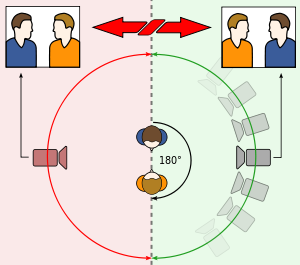When filming and editing our Preliminary task, we encountered various challenges that we had to try and overcome. Unfortunately during filming we were one of the two groups that had to use one of the older cameras that didn’t have an separate external sound recorder and microphone. This caused problems that we didn’t discover until we began editing our footage: the camera quality was quite poor compared to that of the DSLRs and the sound quality was even worse. Due to the lack of microphone we had to make sure our camera shots were quite close up so as the make sure that the sound of the dialogue was picked up by the camera’s microphone, however we didn’t realise how loud the background noise of the room we were in would be; a constant buzzing sound could be heard in the background of the footage. This was mainly due to our poor choice of location for filming, as we chose to film in the computer room. To try and cover up this sound when there wasn’t dialogue we attempted to include various diegetic sound over the top during editing: we added in the ticking of a watch to emphasise the impatience of the interviewer and the lateness of the interviewee, and we also added the squeak of a door when the interviewee entered the room. This, however, was not particularly successful and the buzzing could still be heard.
After filming and editing, as a class we viewed each piece of footage from all 6 groups in turn and gave feedback and criticism to them, and received a mix of positive and negative criticism ourselves to highlight areas for improvement. The diegetic sound of the watch ticking that we put over the top of the footage didn’t match up the actual watch ticks that could be seen in part of the footage, as the editing was partly rushed and we hadn’t paid enough attention to detail, which is something we shall do next time. The hum and buzzing noise in the background of our footage due to poor choice of location was another point that was mentioned, so when filming next we will pay more attention to and think more about choosing the filming locations, and any background noise they may produce. Next time we will probably choose to not use hand-held camera shots, because when we did when filming this task it left quite wobbly footage and seemed unprofessional. We maybe chose not the best combination of camera shots as some of them didn’t quite work together, so next time we will hopefully have more time to spend thinking about camera shot combinations and their effectiveness. When the interviewee entered the room the camera filled them to their chair from the inside of the room, and this didn’t best show ‘someone entering a room’; it would have been better for the camera to follow them through the door from the outside of the room to their chair. During the filming we took enough footage and had several takes for each shot to make sure we had got the footage as we wanted it, but when it came to editing we used all the footage we had taken, and didn’t have any ‘spare’ footage so if we had needed more due to problems then we would have been in trouble. To be honest we probably did need more footage overall anyway because our footage, when edited, cut down and put together, was quite short and would have benefited from being longer.
Even though we encountered problems and made mistakes during planning, filming and editing I still enjoyed the task and am looking forward to doing the next so we can improve on what we did wrong in this one.











